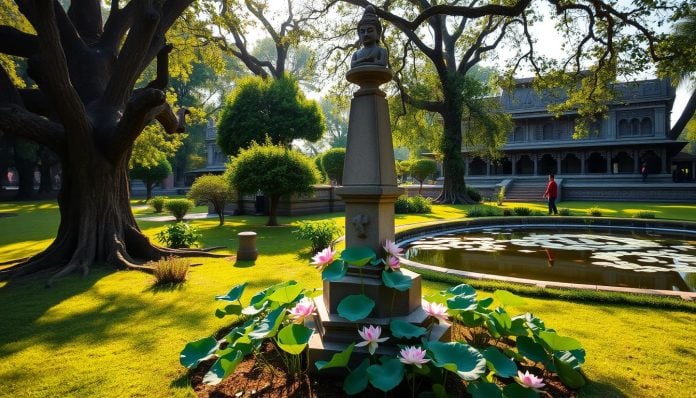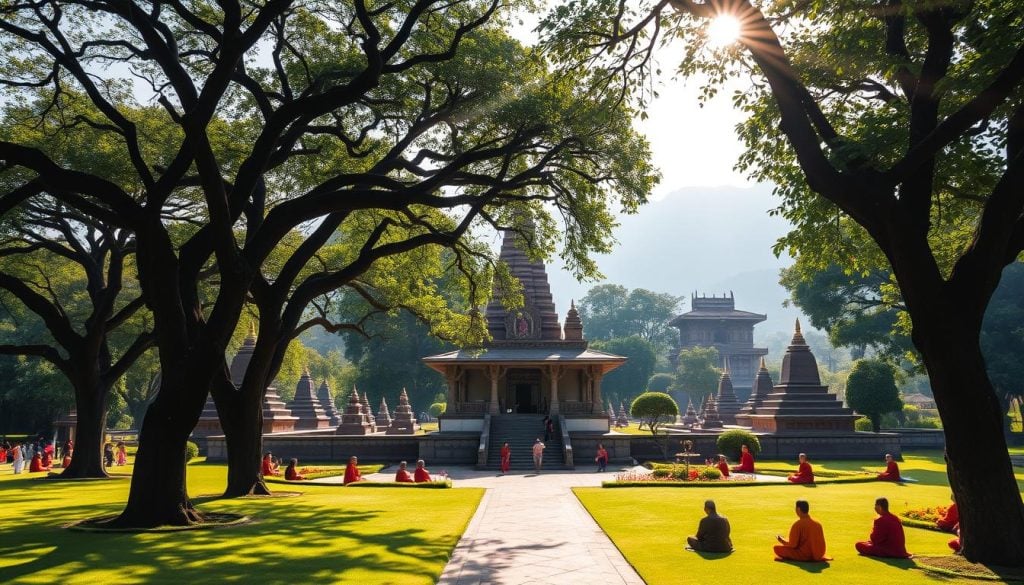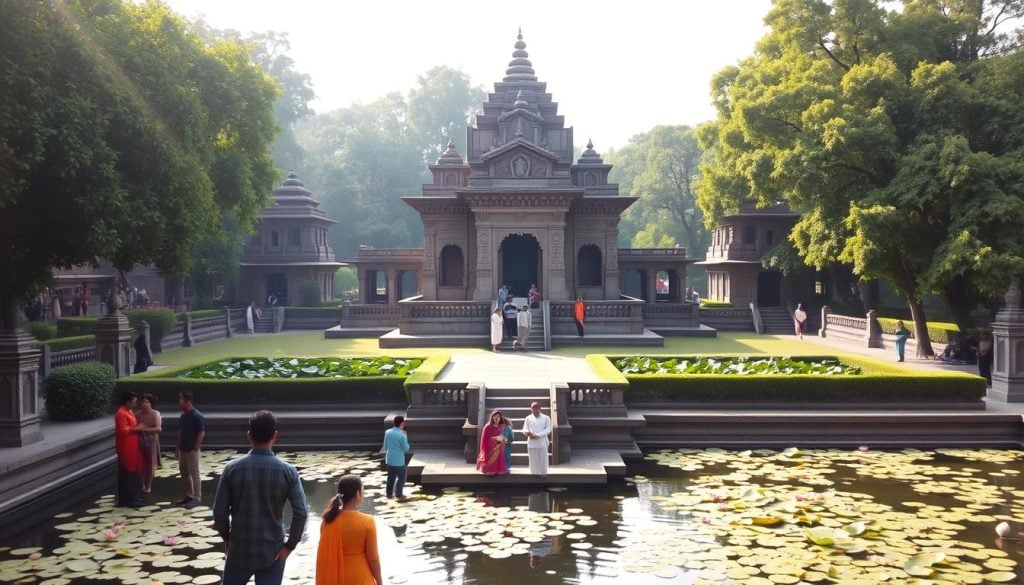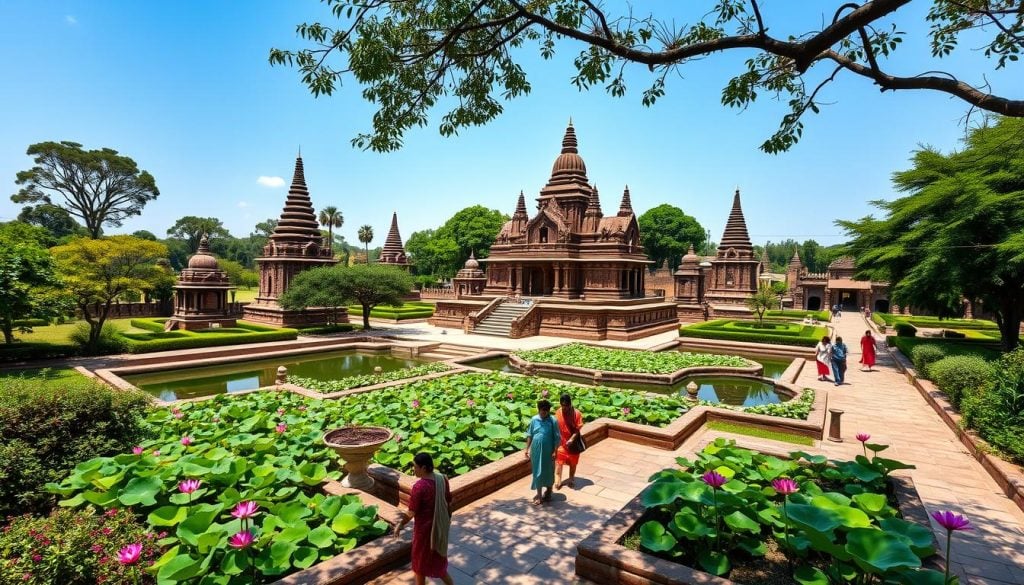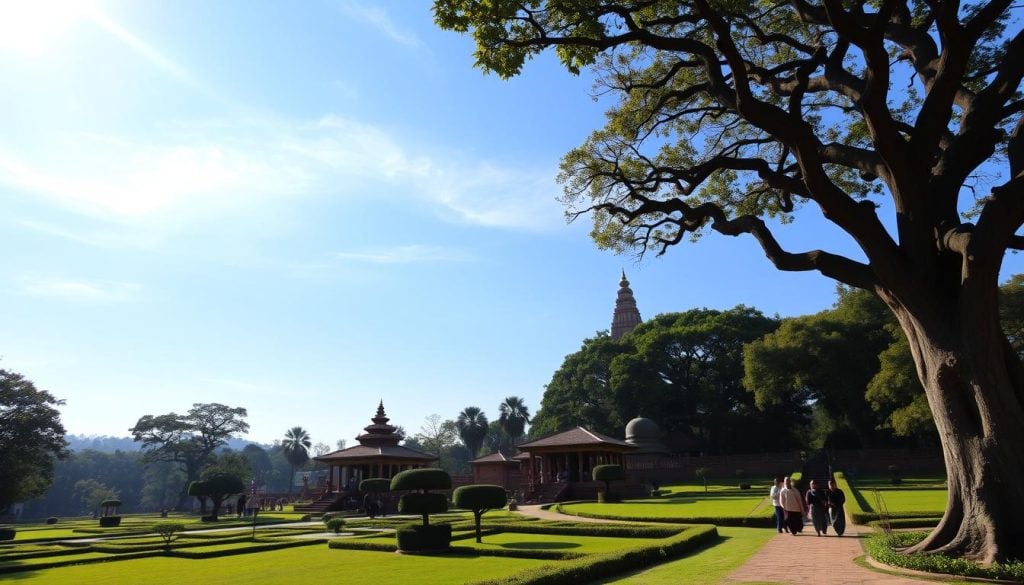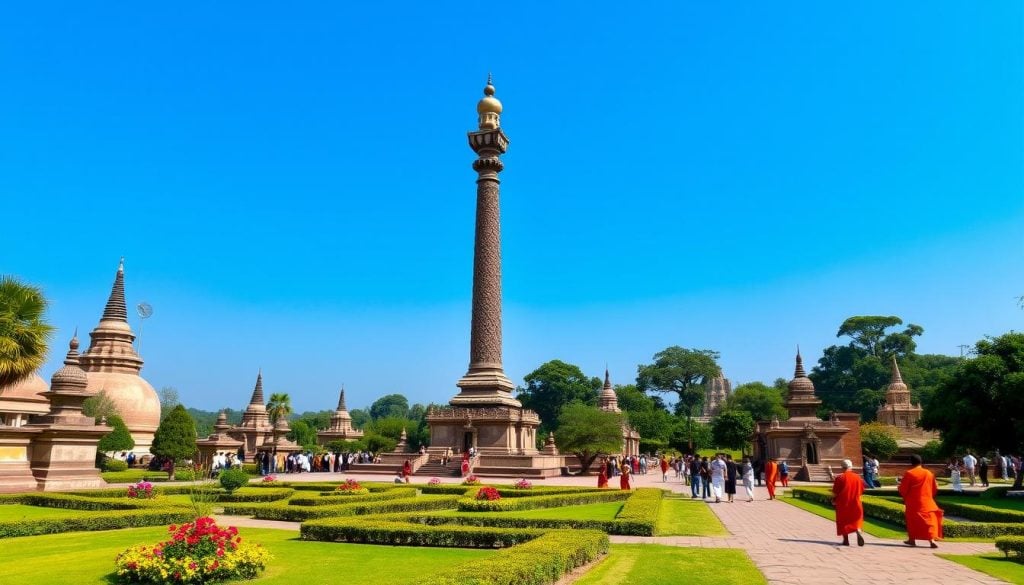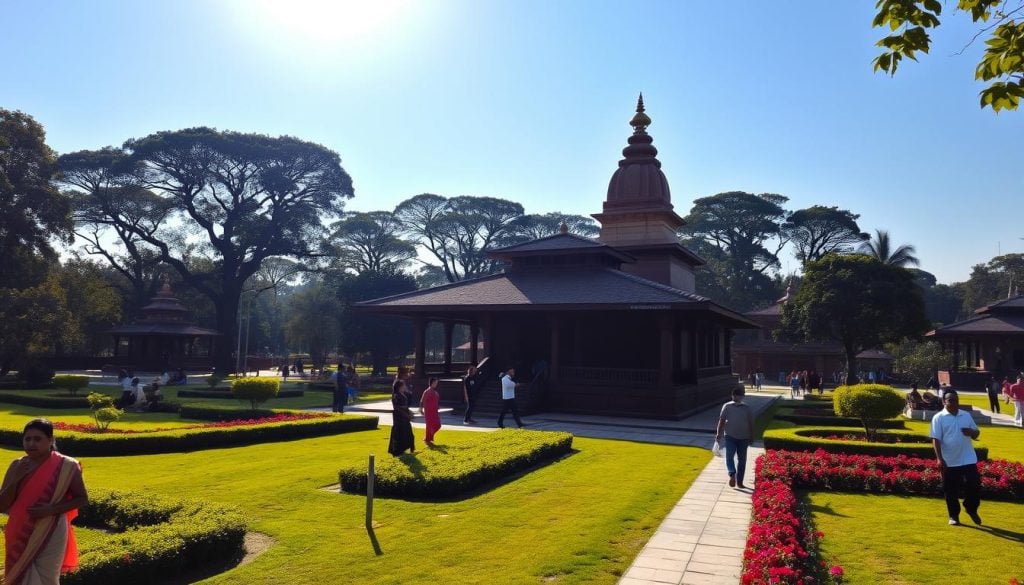Ever thought about walking where Buddha was born? Lumbini, in Nepal’s southern plains, is more than a famous spot. It’s a place where you can feel Buddha’s spirit. Here, travelers and seekers find a deep connection with history and teachings.
This Lumbini travel guide will take you on a journey. You’ll discover history, spirituality, and self-reflection that still touches hearts today.
A Brief History of Lumbini
Lumbini is a key place in Buddhism, where Siddhartha Gautama, the Buddha, was born. It attracts many pilgrims and scholars because of its Lumbini historical significance. Exploring Lumbini deepens your understanding of this sacred site.
Significance of Lumbini as Buddha’s Birthplace
Queen Maya Devi gave birth to Siddhartha around 563 BCE in Lumbini. This event started a spiritual journey that led to Buddhism. Today, Lumbini is a key pilgrimage site for those interested in Buddhist teachings.
The site’s importance is highlighted by its role as the Buddha birthplace Lumbini. It shows the lasting impact of Buddhism across cultures and time.
The Role of Emperor Ashoka in Lumbini’s History
Emperor Ashoka visited Lumbini in 249 BCE. His visit was crucial; he built the Ashoka Pillar to mark the Buddha’s birthplace. The pillar’s inscription is a key archaeological find, adding to Lumbini’s Lumbini historical significance.
This event shows the deep respect for Lumbini throughout history. It also shows the efforts to preserve its spiritual legacy.
| Historical Event | Date | Significance |
|---|---|---|
| Birth of Siddhartha Gautama | Around 563 BCE | Marked the start of Buddhism |
| Visit of Emperor Ashoka | 249 BCE | Erection of the Ashoka Pillar |
| UNESCO World Heritage Status | 1997 | International recognition of cultural significance |
Discovering Buddha’s Birthplace: Maya Devi Temple
The Maya Devi Temple is at the heart of Lumbini. It’s a key spot in this sacred site. It’s where Buddha was born, making it a must-visit for many.
Exploring this site, you’ll find its rich history and spiritual importance.
Historical Importance of the Maya Devi Temple
This temple is very important historically. It has a stone marker showing where Buddha was born. You can also see a beautiful ancient sculpture of Queen Maya Devi giving birth.
The temple’s design and art show Buddhism’s deep cultural roots and history.
The Sacred Pool: Puskarni or Maya Devi Pond
Next to the Maya Devi Temple is the sacred pool, Puskarni. It’s where Queen Maya Devi bathed before Buddha’s birth. The calm around the pool adds to the temple’s spiritual feel.
Visiting here, you’ll understand the temple and pond’s deeper meanings.
| Feature | Description |
|---|---|
| Maya Devi Temple | Marks the birthplace of Buddha, contains sacred marker stone and sculpture of Queen Maya Devi. |
| Puskarni Pool | Believed to be where Queen Maya bathed before giving birth, enhancing the spiritual environment. |
Lumbini as a UNESCO Heritage Site
Lumbini, a UNESCO heritage site since 1997, is the birthplace of Buddha. It’s a place of great cultural and spiritual value. This status shows its importance worldwide, highlighting its role in Buddhism and human history.
Criteria for UNESCO World Heritage Status
The site got UNESCO status for several reasons. These reasons show its value to everyone:
- It’s linked to events that are important to all, especially the life of Buddha.
- It has unique buildings and structures from centuries ago.
- It helps us understand Buddhist traditions and practices.
The Impact of Recognition on Pilgrimage and Tourism
Since being recognized, Lumbini has seen more visitors. This has made it a lively place for cultural exchange. The area’s economy has grown, helping local businesses and the tourism industry.
- More money for local businesses and tourism.
- Chances for cultural exchange, making visits richer for everyone.
- Access to educational and spiritual resources, improving the pilgrimage.
Monastic Zones: Explore Diverse Buddhist Traditions
Lumbini monastic zones are a colorful mix of Buddhist traditions. They attract those looking for spiritual growth and knowledge. The zones are split into East and West, showing different Buddhist ways and practices.
Overview of East and West Monastic Zones
The East Monastic Zone mainly features Theravada Buddhism monasteries. Visitors see simple designs and traditional styles here. These reflect the countries that follow this tradition.
The West Monastic Zone, on the other hand, is all about Vajrayana and Mahayana Buddhism. It has grand buildings with detailed carvings and bright colors.
Unique Features of Each Monastery
Every monastery in these zones has its own story. For instance:
- East Monastic Zone: It’s all about meditation and community, typical of Theravada.
- West Monastic Zone: It’s known for its big rituals and beautiful art, found in Vajrayana and Mahayana.
Visiting Lumbini’s monastic zones is a chance to learn about many Buddhist traditions. It helps us understand how they promote peace, wisdom, and community.
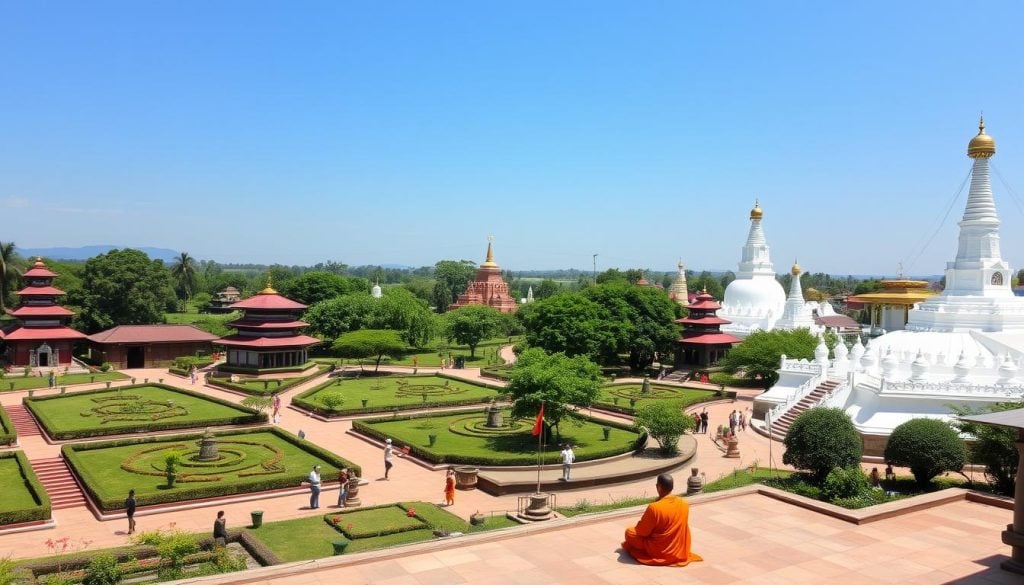
| Monastic Zone | Buddhist Tradition | Architectural Style |
|---|---|---|
| East Monastic Zone | Theravada Buddhism | Simplistic and Traditional |
| West Monastic Zone | Vajrayana and Mahayana Buddhism | Ornate and Colorful |
Can you learn about Buddha’s life in Lumbini?
Yes, Lumbini is a great place to learn about Buddha’s life. There are many educational programs and guided tours. These help you understand the history of this sacred site.
Knowledgeable guides, like Buddhist monks or local historians, share their insights. They make your visit more meaningful by adding context to the landmarks.
Educational Programs and Guided Tours
Educational programs in Lumbini help you understand Buddha’s life better. They create an immersive experience where you can learn about Buddhism. Guided tours include:
- Visits to important historical sites.
- Interactive discussions about Buddhist teachings.
- Opportunities to ask questions and learn directly from knowledgeable individuals.
Insights from Buddhist Monks and Historians
Insights from Buddhist monks and historians make your experience richer. They share unique perspectives on Lumbini’s locations. Their wisdom helps you see how Buddha’s teachings are still important today.
Through these programs and tours, you can learn a lot about Buddha’s life in Lumbini. You can also think about the lessons his teachings still offer.
Visiting the Sacred Garden
The Lumbini Sacred Garden is a peaceful retreat. It’s filled with beautiful landscapes and spiritual significance. Here, visitors can connect with Buddha’s teachings in a serene setting.
Features of the Sacred Garden
In the Lumbini Sacred Garden, you’ll find many elements that make it peaceful. Some key features include:
- Eternal Peace Flame: A symbol of peace lighting the way for seekers of truth.
- Meditation Centers: Spaces designed for quiet reflection and deep introspection.
- Beautiful Landscapes: Manicured gardens that invite you to relax in their serene environment.
Activities for Reflection and Meditation
Engaging in meditation in Lumbini is easy in the Sacred Garden. You can find the following opportunities:
- Guided Meditation Sessions: Participate in organized sessions led by experienced instructors.
- Solo Reflection Time: Find your own peaceful spot to meditate and ponder Buddha’s teachings.
- Mindfulness Practices: Integrate mindfulness into your visit through various techniques.
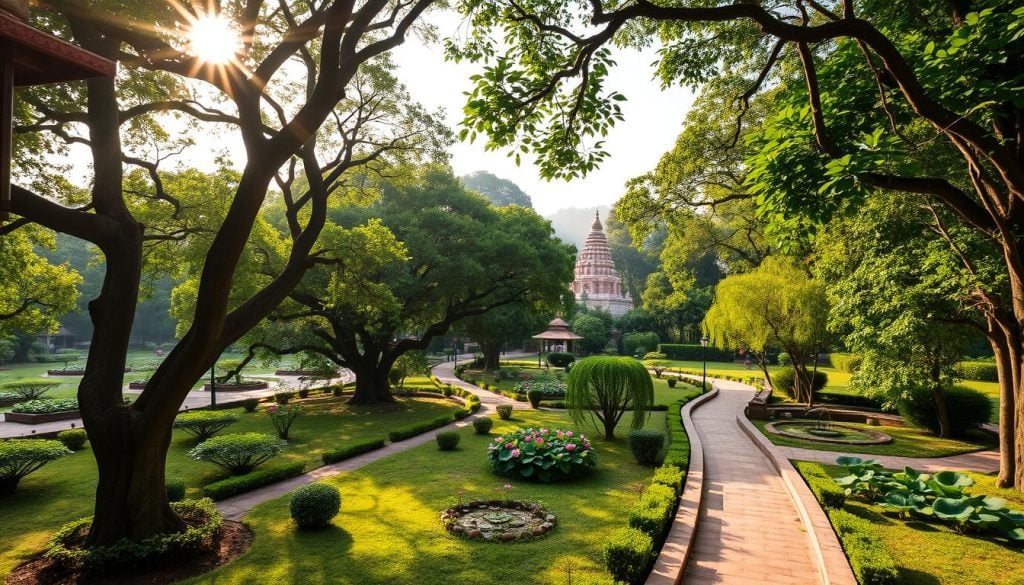
Important Attractions Beyond the Birthplace
Lumbini is more than just the Maya Devi Temple. It has other attractions that show the depth of Buddhism. The Ashoka Pillar is a key site, marking Buddha’s birth. It shows the long history of reverence for this place.
Visit the Ashoka Pillar and its Historical Significance
The Ashoka Pillar is a UNESCO World Heritage Site. Emperor Ashoka built it in the 3rd century BCE. It has inscriptions that highlight Lumbini’s importance.
This pillar is about 6.5 meters tall. It marks the birthplace of Siddhartha Gautama, or Buddha.
Exploring the Lumbini Museum
The Lumbini Museum is a treasure trove of Buddhist history. It has around 12,000 artifacts, like sculptures and inscriptions. These exhibits show the life of Buddha and the culture of Buddhism.
Visitors gain a deeper understanding of Lumbini’s role in Buddhism. It’s a place that shows the rich history and culture of Buddhism.
| Attraction | Significance | Highlights |
|---|---|---|
| Ashoka Pillar | Marks Buddha’s birthplace | Ancient inscriptions, unique architecture |
| Lumbini Museum | Sheds light on Buddhist heritage | 12,000 artifacts, historical context |
| Maya Devi Temple | Birthplace of Buddha | Sacred pond, historical relevance |
Preparing for Your Visit to Lumbini
Planning your trip to Lumbini? Think about when to go. Knowing the seasons and where to stay can make your trip better. This guide will help you get ready for your journey.
Best Time to Visit Lumbini
The best time to see Lumbini is from October to March. The weather is cooler, making your visit more enjoyable. You’ll also catch many local festivals, diving deep into the spiritual culture.
Accommodation and Transportation Options
Choosing where to stay in Lumbini is easy, with many options. You can pick from simple guesthouses to cozy hotels. Booking ahead is a good idea during busy times. Getting to Lumbini is easy, with flights to Gautam Buddha Airport in Bhairahawa. A short drive from there will take you to this amazing place.
Conclusion
Lumbini is a special place where you can learn about Buddha’s life. It’s the birthplace of Siddhartha Gautama and a UNESCO World Heritage site. Here, you can feel the deep spirituality and cultural traditions.
Every corner of Lumbini shows Buddha’s teachings. You can visit the Maya Devi Temple and the Sacred Garden. These places offer a peaceful experience.
Your visit to Lumbini can be very enriching. It helps you understand Buddhism in a real way. Use this travel guide to see important places like the Ashoka Pillar and the Lumbini Museum.
Talking to local monks and historians is also a great idea. They can share insights into Buddha’s teachings. This makes your pilgrimage experience even more meaningful.
Before you go, think about what Lumbini can offer you. It’s not just a beautiful place. It’s a chance to find peace and reflect on your own path.

































